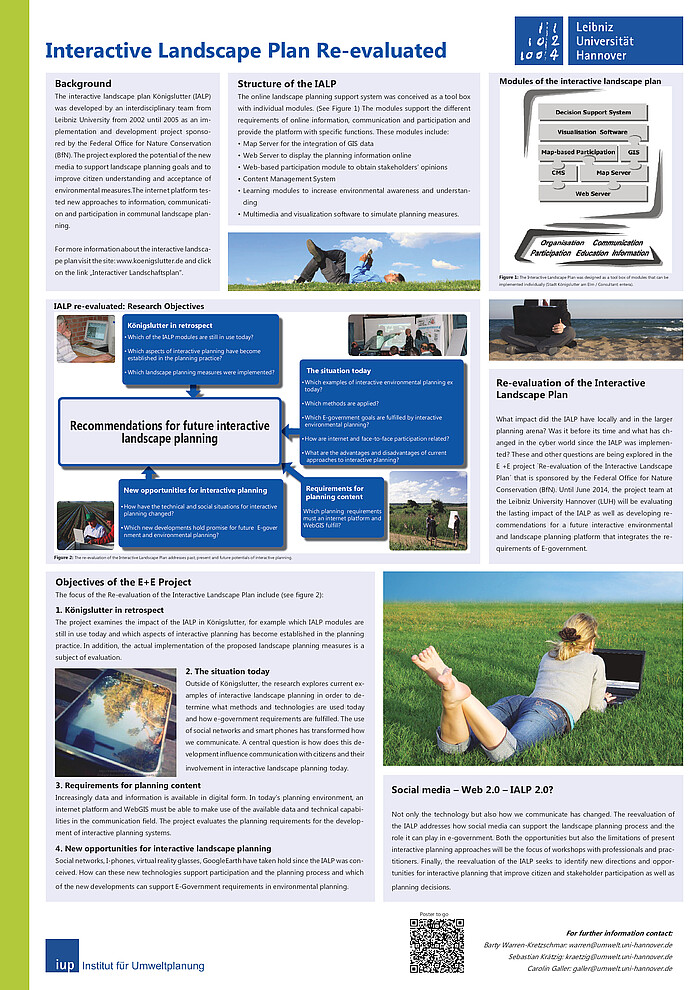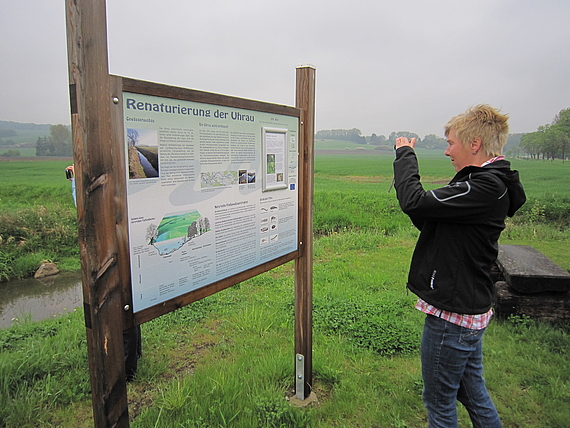Evaluation of the interactive landscape plan in Königslutter

| Led by: | Prof. Dr. Christina von Haaren, Dr. Barty Warren-Kretschmar |
| Team: | Dipl.-Ing. Carolin Galler, M.A. Sebastian Krätzig (both IUP); Prof. Dr. Bettina Oppermann, Dipl.-Ing. Friederike Maus (both IF) |
| Year: | 2014 |
| Funding: | Federal Agency for Nature Conservation (BfN) |
| Duration: | January 2013 - September 2014 |
| Is Finished: | yes |
Evaluation of the interactive landscape plan in Königslutter
Summary
In the project "Evaluation of the interactive landscape plan in Königslutter", funded by the Federal Agency for Nature Conservation, new technical developments and interactive possibilities for public participation in environmental planning were explored. From a review of the interactive landscape plan in Königslutter am Elm (2002-2007), empirical values for future implementations were derived. In addition, current case studies of interactive environmental planning and fields of application of new media (Web 2.0 etc.) in environmental planning were examined.
The following questions were the focus: What do the administrative processes look like in relation to planning in the case studies? Do interactive participation offerings take into account the informal networks on the Internet (social networks), which are growing in importance, and the public's desire for transparency? The web information and participation modules found in the case studies were examined against the backdrop of the national eGovernment strategy to determine their suitability with regard to changing forms of citizen behavior on the Internet. Recommendations for the use of interactive elements in future environmental planning can be found in the following publications.
Research results
Lipski, Astrid & Hachmann, Roland (2015): Interaktive Beteiligung - aktueller, technischer Status Quo & Visionen. IP SYSCON GmbH. (pdf)
Oppermann, Bettina (2015): Die Gepflogenheiten der Internetkommunikation, neue und falsche Freunde der Landschaftsplanung. (pdf)
Maus, Friederike (2015): Konfliktpotenziale in der Landschaftsplanung. Identifikation und Umgang. Überlegungen zum Umgang mit widerborstigen Prozessen am Beispiel Esslingen. (pdf)
Krätzig, Sebastian (2015): Neue Möglichkeiten der Online-Kommunikation für Bürgerbeteiligung in der Landschaftsplanung. (pdf)
Krätzig, Sebastian & Warren-Kretzschmar, Bartlett (2014): Using Interactive Web Tools in Environmental Planning to Improve Communication about Sustainable Development. In: Sustainability 6 (1): 236-250.
Galler, Carolin; Krätzig, Sebastian; Warren-Kretzschmar, Bartlett & Haaren, Christina von (2014): Integrated Approaches in Digital / Interactive Landscape Planning. In: Wissen Hayek, U., Fricker, P. & Buhmann, E. (eds.): Peer Reviewed Proceedings of Digital Landscape Architecture 2014 at ETH Zurich. Herbert Wichmann Verlag, VDE VERLAG GMBH: Berlin/Offenbach. Link
Project poster (presented at the Digital Landscape Architecture, 06.-08.06.2013 in Bernburg, Germany)



Kick-off workshop in May 2013
At the first of two workshops on 07 and 08 May 2013 in Königslutter, the then E+E project of the Interactive Landscape Plan Königslutter was followed up. The aim of this first workshop was to look at the results of the landscape plan in nature and administrative practice. Which landscape measures were implemented? What has remained lasting from the internet platform? Does the administration still use individual components for participation and visualization? From this retrospective, the workshop developed the current state of the discussion on interactive possibilities in environmental planning with the help of numerous invited experts and practitioners. Which technical and administrative framework conditions have changed since then? How do current examples in the field of planning work with formal and informal public participation? It turned out that the dimensions of implementation at that time are still relevant today, but the possibilities for this have improved significantly. The Internet with its applications and end devices has moved much further into the private lives of citizens. New forms of communication and visualization are becoming more and more commonplace. Nevertheless, the discussion about the feasibility and limits of interactive planning remains topical.











